engine TOYOTA FJ CRUISER 2014 1.G Quick Reference Guide
[x] Cancel search | Manufacturer: TOYOTA, Model Year: 2014, Model line: FJ CRUISER, Model: TOYOTA FJ CRUISER 2014 1.GPages: 15, PDF Size: 7.21 MB
Page 2 of 15
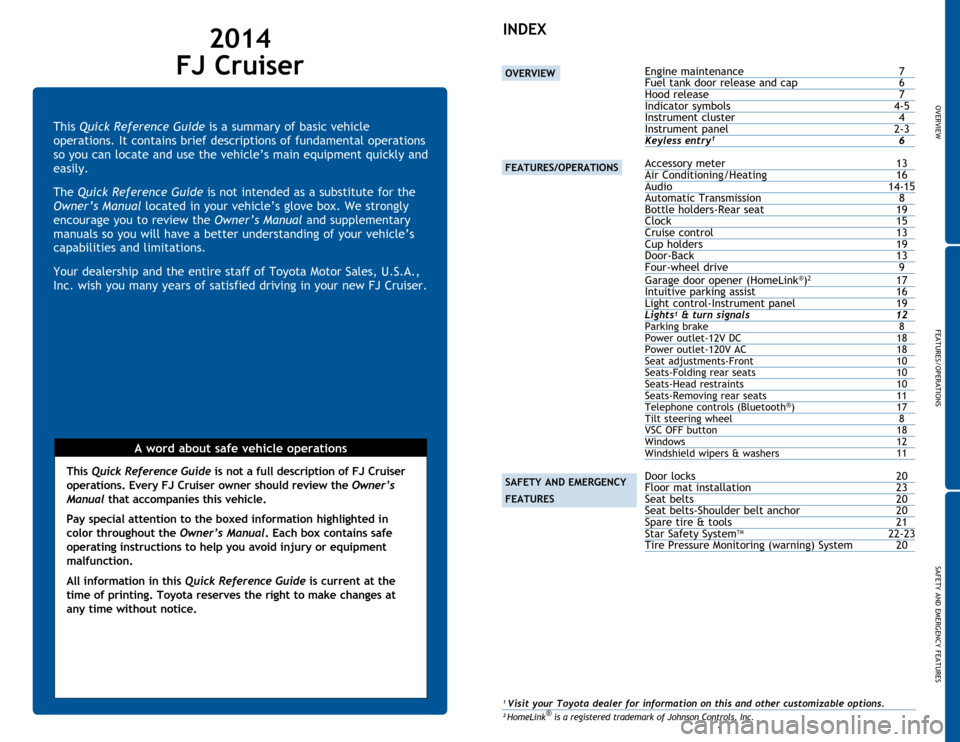
OVERVIEW
FEATURES/OPERATIONS
SAFETY AND EMERGENCY FEATURES
1
This Quick Reference Guide is a summary of basic vehicle
operations. It contains brief descriptions of fundamental operations
so you can locate and use the vehicle’s main equipment quickly and
easily.
The Quick Reference Guide is not intended as a substitute for the
Owner’s Manual located in your vehicle’s glove box. We strongly
encourage you to review the Owner’s Manual and supplementary
manuals so you will have a better understanding of your vehicle’s
capabilities and limitations.
Your dealership and the entire staff of Toyota Motor Sales, U.S.A.,
Inc. wish you many years of satisfied driving in your new FJ Cruiser.
A word about safe vehicle operations
This Quick Reference Guide is not a full description of FJ Cruiser
operations. Every FJ Cruiser owner should review the Owner’s
Manual that accompanies this vehicle.
Pay special attention to the boxed information highlighted in
color throughout the Owner’s Manual. Each box contains safe
operating instructions to help you avoid injury or equipment
malfunction.
All information in this Quick Reference Guide is current at the
time of printing. Toyota reserves the right to make changes at
any time without notice.
2014
FJ Cruiser
INDEX
Engine maintenance 7
Fuel tank door release and cap 6
Hood release 7
Indicator symbols 4-5
Instrument cluster 4
Instrument panel 2-3
Keyless entry1 6 Accessory meter 13
Air Conditioning/Heating 16
Audio 14-15
Automatic Transmission 8
Bottle holders-Rear seat 19
Clock 15
Cruise control 13
Cup holders 19
Door-Back 13
Four-wheel drive 9
Garage door opener (HomeLink
®)2 17
Intuitive parking assist 16
Light control-Instrument panel 19
Lights1 & turn signals 12
Parking brake 8
Power outlet-12V DC 18
Power outlet-120V AC 18
Seat adjustments-Front 10
Seats-Folding rear seats 10
Seats-Head restraints 10
Seats-Removing rear seats 11
Telephone controls (Bluetooth
®) 17
Tilt steering wheel 8
VSC OFF button 18
Windows 12
Windshield wipers & washers
11 Door locks 20
Floor mat installation 23
Seat belts 20
Seat belts-Shoulder belt anchor 20
Spare tire & tools 21
Star Safety System
TM 22-23
Tire Pressure Monitoring (warning) System 20
1 Visit your Toyota dealer for information on this and other customizable options.2 HomeLink® is a registered trademark of Johnson Controls, Inc.
OVERVIEW
FEATURES/OPERATIONS
SAFETY AND EMERGENCY
FEATURES
Page 3 of 15
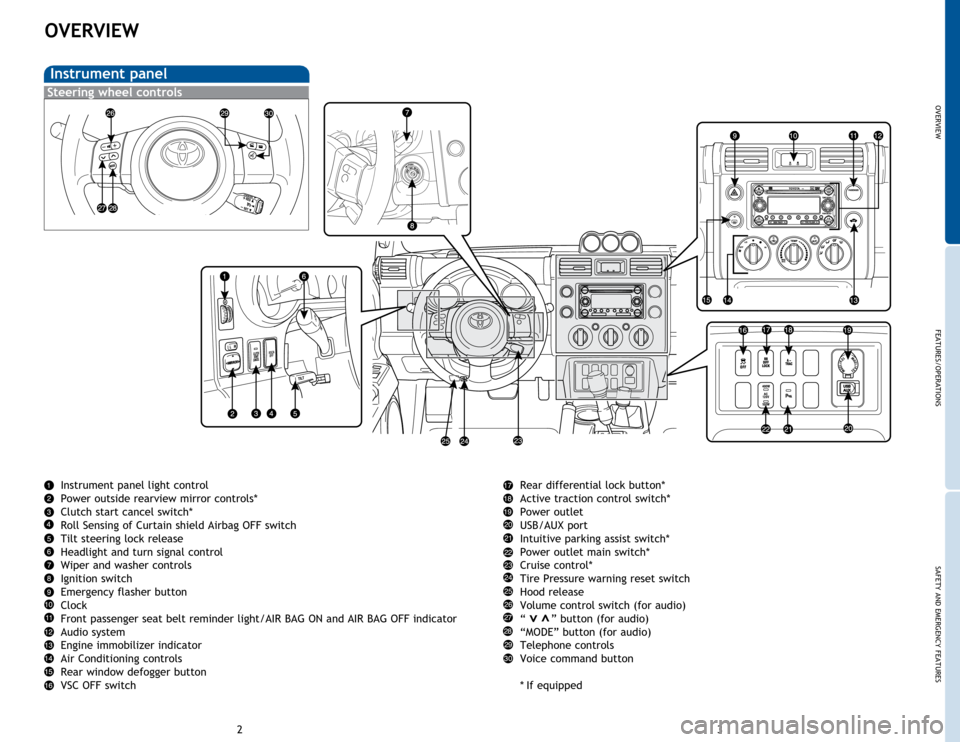
OVERVIEW
FEATURES/OPERATIONS
SAFETY AND EMERGENCY FEATURES
23
OVERVIEW
Rear differential lock button*
Active traction control switch*
Power outlet
USB/AUX port
Intuitive parking assist switch*
Power outlet main switch*
Cruise control*
Tire Pressure warning reset switch
Hood release
Volume control switch (for audio)
“ ” button (for audio)
“MODE” button (for audio)
Telephone controls
Voice command button
*
If equipped
>>
Instrument panel
Instrument panel light control
Power outside rearview mirror controls*
Clutch start cancel switch*
Roll Sensing of Curtain shield Airbag OFF switch
Tilt steering lock release
Headlight and turn signal control
Wiper and washer controls
Ignition switch
Emergency flasher button
Clock
Front passenger seat belt reminder light/AIR BAG ON and AIR BAG OFF indicator
Audio system
Engine immobilizer indicator
Air Conditioning controls
Rear window defogger button
VSC OFF switch
Steering wheel controls
Page 4 of 15
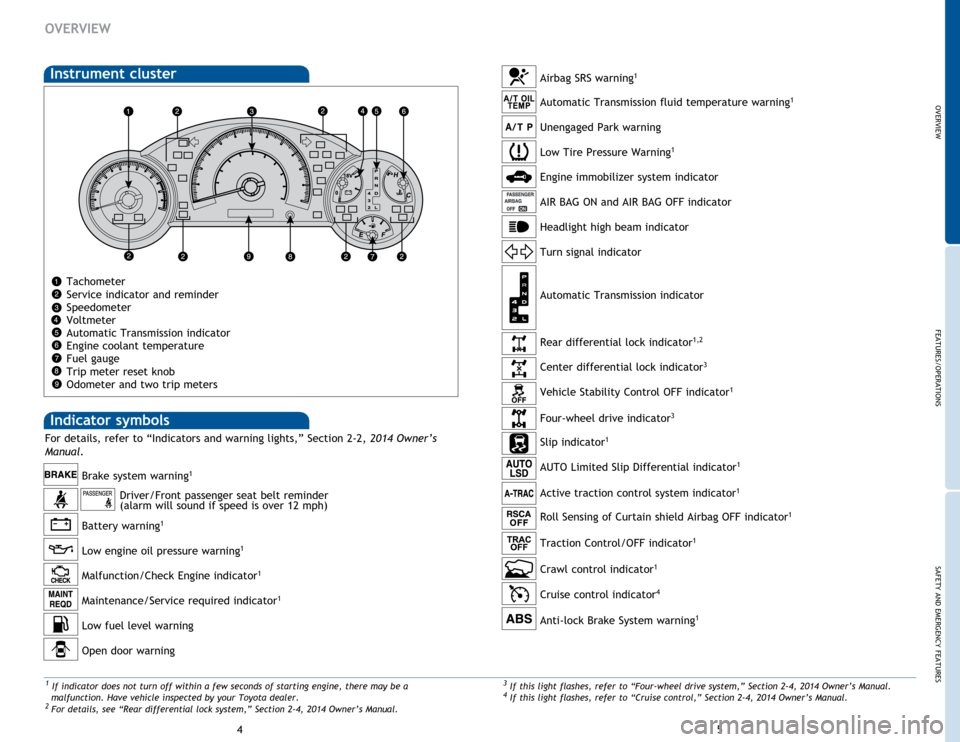
OVERVIEW
FEATURES/OPERATIONS
SAFETY AND EMERGENCY FEATURES
45
OVERVIEW
Automatic Transmission indicator
AIR BAG ON and AIR BAG OFF indicator
Turn signal indicator
Four-wheel drive indicator
3
Rear differential lock indicator1,2
Center differential lock indicator3
Slip indicator1
Vehicle Stability Control OFF indicator1
Active traction control system indicator1
AUTO Limited Slip Differential indicator1
Cruise control indicator4
Crawl control indicator1
Automatic Transmission fluid temperature warning1
Unengaged Park warning
Airbag SRS warning1
Headlight high beam indicator
Anti-lock Brake System warning
1
3 If this light flashes, refer to “Four-wheel drive system,” Section 2-4, 2014 Owner’s Manual.4 If this light flashes, refer to “Cruise control,” Section 2-4, 2014 Owner’s Manual.
Low Tire Pressure Warning1
Engine immobilizer system indicator
Roll Sensing of Curtain shield Airbag OFF indicator1
Traction Control/OFF indicator1
Indicator symbols
Instrument cluster
Tachometer
Service indicator and reminder
Speedometer
Voltmeter
Automatic Transmission indicator
Engine coolant temperature
Fuel gauge
Trip meter reset knob
Odometer and two trip meters
Battery warning1
Low engine oil pressure warning1
Brake system warning1
Malfunction/Check Engine indicator1
Maintenance/Service required indicator1
Driver/Front passenger seat belt reminder
(alarm will sound if speed is over 12 mph)
Open door warning
1 If indicator does not turn off within a few seconds of starting engine, there may be a
malfunction. Have vehicle inspected by your Toyota dealer.
2 For details, see “Rear differential lock system,” Section 2-4, 2014 Owner’s Manual.
Low fuel level warning
For details, refer to “Indicators and warning lights,” Section 2-2, 2014 Owner’s
Manual.
Page 5 of 15
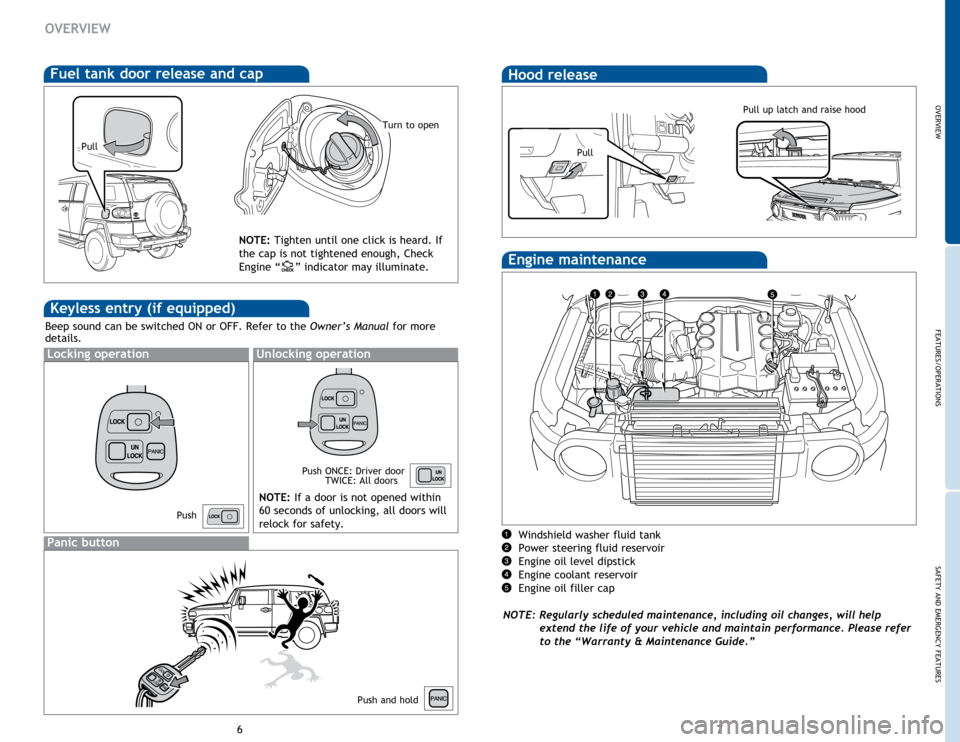
OVERVIEW
FEATURES/OPERATIONS
SAFETY AND EMERGENCY FEATURES
67
Hood release
Pull up latch and raise hood
Windshield washer fluid tank
Power steering fluid reservoir
Engine oil level dipstick
Engine coolant reservoir
Engine oil filler cap
NOTE: Regularly scheduled maintenance, including oil changes, will help extend the life of your vehicle and maintain performance. Please refer
to the “Warranty & Maintenance Guide.”
Engine maintenance
OVERVIEW
Fuel tank door release and cap
Pull
Turn to open
NOTE: Tighten until one click is heard. If
the cap is not tightened enough, Check
Engine “
” indicator may illuminate.
Keyless entry (if equipped)
Beep sound can be switched ON or OFF. Refer to the Owner’s Manual for more
details.
NOTE: If a door is not opened within
60 seconds of unlocking, all doors will
relock for safety.
Panic button
N
U
K
C
O
L
K
C
O
LC
I
N
A
P
Locking operationUnlocking operation
Push
Push and hold
Push
ONCE: Driver door
TWICE: All doors
Pull
Page 6 of 15
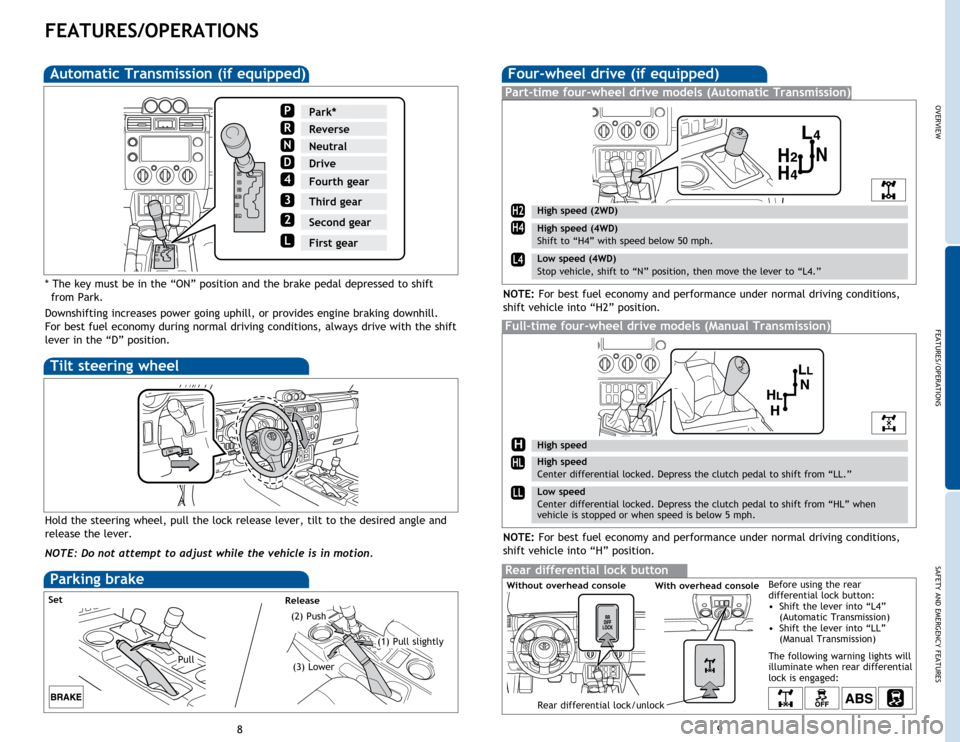
OVERVIEW
FEATURES/OPERATIONS
SAFETY AND EMERGENCY FEATURES
89
Four-wheel drive (if equipped)
Full-time four-wheel drive models (Manual Transmission)
Part-time four-wheel drive models (Automatic Transmission)
High speed (2WD)
High speed (4WD)
Shift to “H4” with speed below 50 mph.
Low speed (4WD)
Stop vehicle, shift to “N” position, then move the lever to “L4.”
Rear differential lock button
NOTE: For best fuel economy and performance under normal driving conditions,
shift vehicle into “H2” position.
Rear differential lock/unlock
Low speed
Center differential locked. Depress the clutch pedal to shift from “HL” when
vehicle is stopped or when speed is below 5 mph.
HL
LL
H
Before using the rear
differential lock button:
• Shift the lever into “L4”
(Automatic Transmission)
• Shift the lever into “LL”
(Manual Transmission)
The following warning lights will
illuminate when rear differential
lock is engaged:
NOTE: For best fuel economy and performance under normal driving conditions,
shift vehicle into “H” position.
High speed
High speed
Center differential locked. Depress the clutch pedal to shift from “LL.”
FEATURES/OPERATIONS
Automatic Transmission (if equipped)
Downshifting increases power going uphill, or provides engine braking downhill.
For best fuel economy during normal driving conditions, always drive with the shift
lever in the “D” position.
Park*P
ReverseR
NeutralN
DriveD
Third gear3
Second gear2
First gearL
4Fourth gear
Tilt steering wheel
Hold the steering wheel, pull the lock release lever, tilt to the desired angle and
release the lever.
NOTE: Do not attempt to adjust while the vehicle is in motion. * The key must be in the “ON” position and the brake pedal depressed to shift from Park.
H2
H4
L4
Without overhead consoleWith overhead console
ReleaseSet
Pull
(1) Pull slightly
(2) Push
(3) Lower
Parking brake
Page 11 of 15
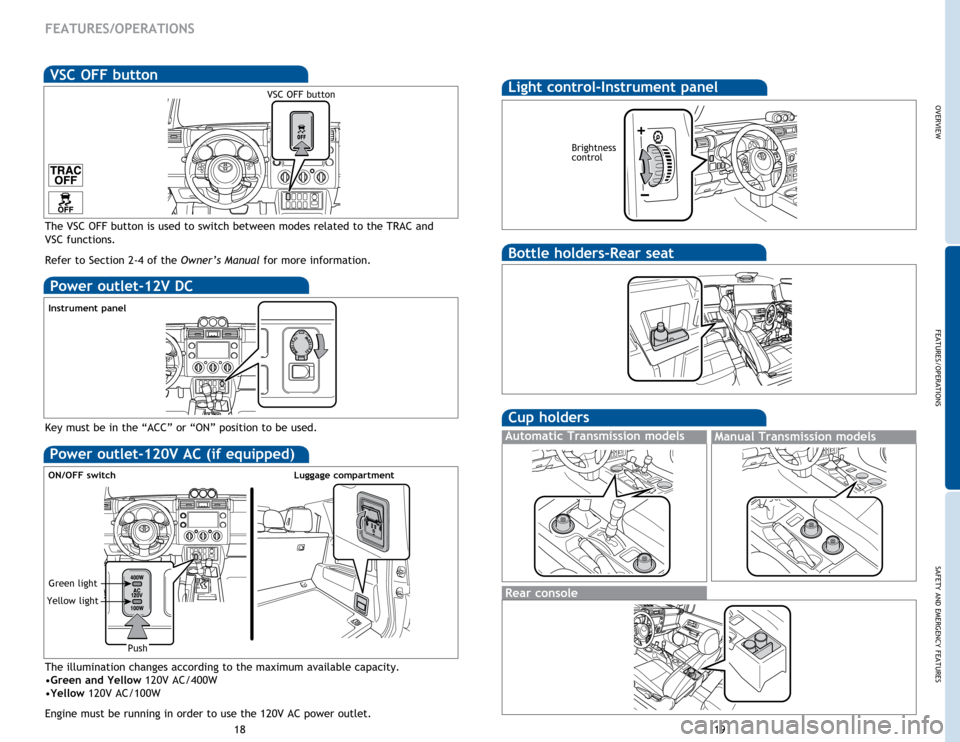
OVERVIEW
FEATURES/OPERATIONS
SAFETY AND EMERGENCY FEATURES
19
18
Bottle holders-Rear seat
Cup holders
Rear console
Manual Transmission models
Automatic Transmission models
Power outlet-12V DC
Instrument panel
The illumination changes according to the maximum available capacity.
•Green and Yellow
120V AC/400W
•Yellow 120V AC/100W
Engine must be running in order to use the 120V AC power outlet.
Power outlet-120V AC (if equipped)
Key must be in the “ACC” or “ON” position to be used.
FEATURES/OPERATIONS
The VSC OFF button is used to switch between modes related to the TRAC and
VSC functions.
Refer to Section 2-4 of the Owner’s Manual for more information.
VSC OFF button
VSC OFF button
Light control-Instrument panel
Brightness
control
+
ON/OFF switch Luggage compartment
Push
Green light
Yellow light
Page 13 of 15
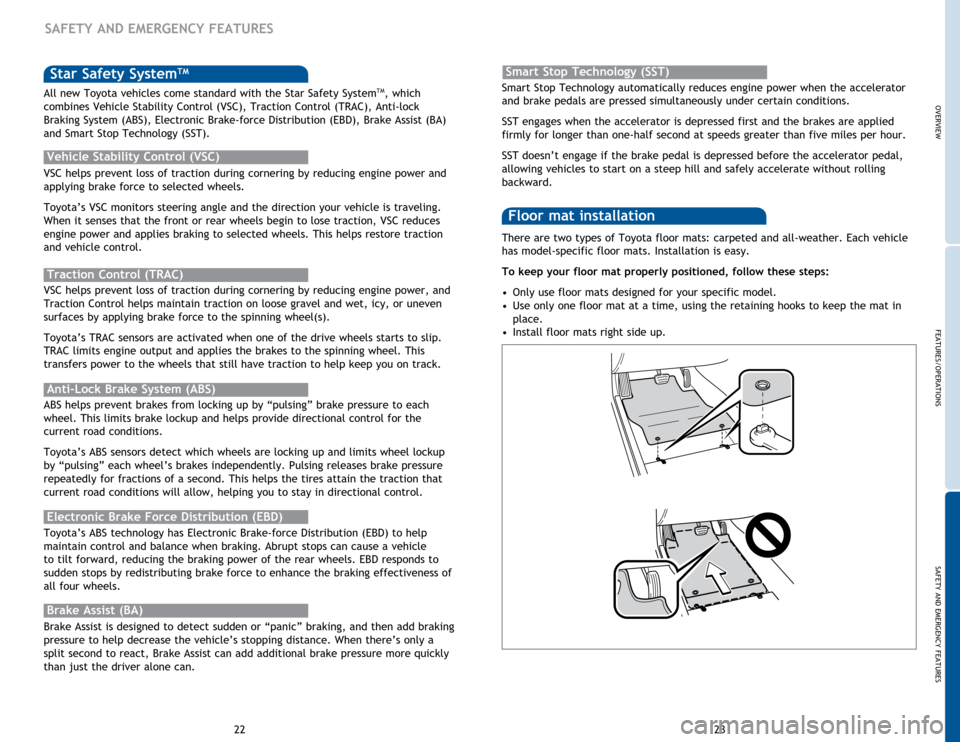
OVERVIEW
FEATURES/OPERATIONS
SAFETY AND EMERGENCY FEATURES
23
22
Star Safety SystemTM
VSC helps prevent loss of traction during cornering by reducing engine power and
applying brake force to selected wheels.
Toyota’s VSC monitors steering angle and the direction your vehicle is traveling.
When it senses that the front or rear wheels begin to lose traction, VSC reduces
engine power and applies braking to selected wheels. This helps restore traction
and vehicle control.
Vehicle Stability Control (VSC)
Anti-Lock Brake System (ABS)
ABS helps prevent brakes from locking up by “pulsing” brake pressure to each
wheel. This limits brake lockup and helps provide directional control for the
current road conditions.
Toyota’s ABS sensors detect which wheels are locking up and limits wheel lockup
by “pulsing” each wheel’s brakes independently. Pulsing releases brake pressure
repeatedly for fractions of a second. This helps the tires attain the traction that
current road conditions will allow, helping you to stay in directional control.
Brake Assist (BA)
Brake Assist is designed to detect sudden or “panic” braking, and then add braking
pressure to help decrease the vehicle’s stopping distance. When there’s only a
split second to react, Brake Assist can add additional brake pressure more quickly
than just the driver alone can. VSC helps prevent loss of traction during cornering by reducing engine power, and
Traction Control helps maintain traction on loose gravel and wet, icy, or uneven
surfaces by applying brake force to the spinning wheel(s).
Toyota’s TRAC sensors are activated when one of the drive wheels starts to slip.
TRAC limits engine output and applies the brakes to the spinning wheel. This
transfers power to the wheels that still have traction to help keep you on track.
Traction Control (TRAC)
Electronic Brake Force Distribution (EBD)
Toyota’s ABS technology has Electronic Brake-force Distribution (EBD) to help
maintain control and balance when braking. Abrupt stops can cause a vehicle
to tilt forward, reducing the braking power of the rear wheels. EBD responds to
sudden stops by redistributing brake force to enhance the braking effectiveness of
all four wheels. There are two types of Toyota floor mats: carpeted and all-weather. Each vehicle
has model-specific floor mats. Installation is easy.
To keep your floor mat properly positioned, follow these steps:
•
Only use floor mats designed for your specific model.
• Use only one floor mat at a time, using the retaining hooks to keep the mat in
place.
• Install floor mats right side up.
Floor mat installation
SAFETY AND EMERGENCY FEATURES
All new Toyota vehicles come standard with the Star Safety SystemTM, which
combines Vehicle Stability Control (VSC), Traction Control (TRAC), Anti-lock
Braking System (ABS), Electronic Brake-force Distribution (EBD), Brake Assist (BA)
and Smart Stop Technology (SST). Smart Stop Technology automatically reduces engine power when the accelerator
and brake pedals are pressed simultaneously under certain conditions.
SST engages when the accelerator is depressed first and the brakes are applied
firmly for longer than one-half second at speeds greater than five miles per hour.
SST doesn’t engage if the brake pedal is depressed before the accelerator pedal,
allowing vehicles to start on a steep hill and safely accelerate without rolling
backward.
Smart Stop Technology (SST)